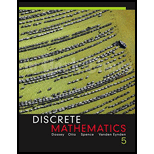
(a)
To find: The number of system of distinct representatives for the sequence of set
(a)
Answer to Problem 1SE
There are
Explanation of Solution
Given:
The sequence of set is
Concept used:
If the finite sequence of sets
Here,
Calculation:
The set
To obtain the number of distinct representative, there are 5 ways to choose an element from the set
Now, there are only 3 ways to select the element from set
Therefore, the number
Thus, the number of distinct representative for the sets
(b)
To find: The number of system of distinct representatives for the sequence of set
(b)
Answer to Problem 1SE
There are
Explanation of Solution
Given:
The sequence of set is
Calculation:
The set
To obtain the number of distinct representative, there are 4 ways to choose an element from the set
Now, there are only 3 ways to select the element from set
Therefore, the number
Thus, the number of distinct representative for the sets
(c)
To find: The number of system of distinct representatives for the sequence of set
(c)
Answer to Problem 1SE
There is
Explanation of Solution
Given:
The sequence of set is
Concept used:
The sequence of set
Here, the elements
Calculation:
The sequence of set can be written as follows:
The union of set
The total number of elements in the above set is 4 such that the elements can be arranged in
The elements
Similarly, there are 18 more ways to arrange the elements
The sequence of set is distinct representative if the above mentioned sequence satisfies the condition that
The general form of the arranged sequences is as follows:
The set
The first element of the set
Therefore, the set
Similarly, all the sets do not satisfy the condition
Thus, there is
Want to see more full solutions like this?
Chapter 6 Solutions
Discrete Mathematics
 Discrete Mathematics and Its Applications ( 8th I...MathISBN:9781259676512Author:Kenneth H RosenPublisher:McGraw-Hill Education
Discrete Mathematics and Its Applications ( 8th I...MathISBN:9781259676512Author:Kenneth H RosenPublisher:McGraw-Hill Education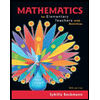 Mathematics for Elementary Teachers with Activiti...MathISBN:9780134392790Author:Beckmann, SybillaPublisher:PEARSON
Mathematics for Elementary Teachers with Activiti...MathISBN:9780134392790Author:Beckmann, SybillaPublisher:PEARSON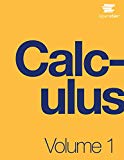
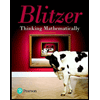 Thinking Mathematically (7th Edition)MathISBN:9780134683713Author:Robert F. BlitzerPublisher:PEARSON
Thinking Mathematically (7th Edition)MathISBN:9780134683713Author:Robert F. BlitzerPublisher:PEARSON Discrete Mathematics With ApplicationsMathISBN:9781337694193Author:EPP, Susanna S.Publisher:Cengage Learning,
Discrete Mathematics With ApplicationsMathISBN:9781337694193Author:EPP, Susanna S.Publisher:Cengage Learning,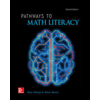 Pathways To Math Literacy (looseleaf)MathISBN:9781259985607Author:David Sobecki Professor, Brian A. MercerPublisher:McGraw-Hill Education
Pathways To Math Literacy (looseleaf)MathISBN:9781259985607Author:David Sobecki Professor, Brian A. MercerPublisher:McGraw-Hill Education





